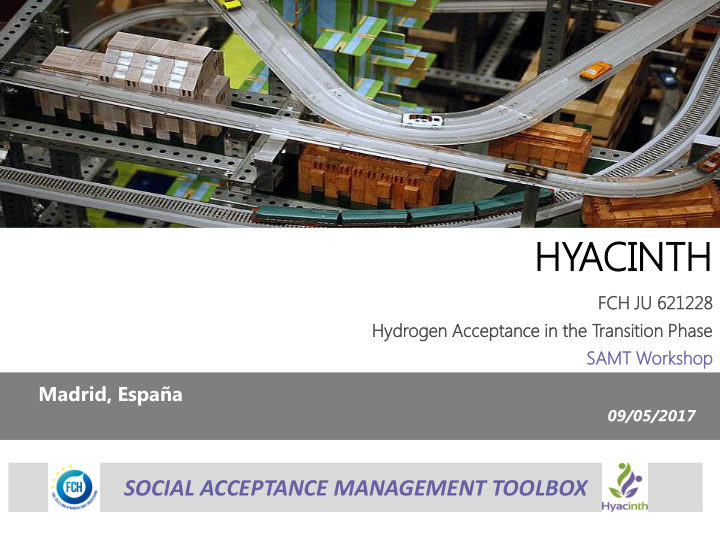



HY HYACIN INTH TH FCH JU 621228 28 Hydrogen gen Accept ptance ance in the Transit sition on Phase SAMT Worksh shop op Madrid, España 09/05/2017 SOCIAL ACCEPTANCE MANAGEMENT TOOLBOX
SAMT WORKSHOP Inputs from research Stakeholder Surveys SAMT Stakeholder Interviews Public Surveys Generates Database of: • Best Practice Attitudes • -ve/+ve • Knowledge • Trust • +ve/-ve affects • Experience • Perceptions • Risk • Cost • Benefits
SAMT WORKSHOP Developer Interrogation • Inputs from research Web based • Interface: • Application • Stationary/mobile • Target user Stakeholder Surveys • Location SAMT • Where will this be Stakeholder Interviews installed/operated • Etc. Public Surveys Generates Best Practice Database of: • Attitudes • -ve/+ve • Experiences • Beliefs • Funding Climate • Political Support
SAMT WORKSHOP SAMT Stakeholders Public Compares data +/+ Both parties agree situation positive +/- Public think situation is better than Stakeholders do -/+ Stakeholders believe situation more positive than public - /- Both parties agree situation is negative
SAMT WORKSHOP
SAMT WORKSHOP
SAMT WORKSHOP
SAMT WORKSHOP
SAMT WORKSHOP
SAMT WORKSHOP
SAMT WORKSHOP • The SAMT then shows the user: – What the current state of public opinion is, – What the views of industry and other stakeholders are. • By comparing these it is possible to make inferences regarding the likelihood of social acceptance. • The tool looks for four situations.
SAMT WORKSHOP • Positive/Positive: here both the public and the stakeholders agree that the situation is positive, i.e. good. • Positive/ Negative: here the public think that the situation is good while stakeholders are less optimistic. • Negative/Positive: here the public have concerns while stakeholders do not see any reason for concern. • Negative/Negative: here both parties believe the situation is generally poor.
SAMT WORKSHOP Increasing Negativity Increasing Positivity Strong -ve Medium -ve Weak -ve Weak +ve Medium +ve Strong +ve 1 2 3 4 5 6 Positive/Positive agreement Negative/Negative Agreement Positive/Negative Disagreement Negative/Positive Disagreement Stakeholder View Public View
SAMT WORKSHOP • The SAMT provides outputs based around 51 questions grouped over eight themes. The themes are: – Theme One: Knowledge & Experience – Theme Two : Trust – Theme Three ; Positive and Negative Affects – Theme Four ; Perceived Effects – Costs, Risks and Benefits – Theme Five : Perceived Consequences – Theme Six : Attitude – Theme Seven : Initial Acceptance – Theme Eight : Acceptance
SAMT WORKSHOP
SAMT WORKSHOP • Our example is based on a fictitious developer of a hydrogen transport application. • After filtering this message appears:
SAMT WORKSHOP
SAMT WORKSHOP
SAMT WORKSHOP • Interpreting the results: – Each section is accompanied by some advisory text which is designed to suggest typical ways in which to address particular problems. – However, before using any of these it will be prudent to try to understand what is actually happening.
SAMT WORKSHOP
SAMT WORKSHOP • Answers to questions posed in this section (A9, 10, 11 & 13) indicate that the industry and other stakeholders are experienced in this field and so their views will be based upon an in depth knowledge of the sector and thus may be trusted as an indicator of prevailing opinion within the stakeholder community. • As anticipated by stakeholders the public’s knowledge of this field is limited. Most have never had the opportunity to experience the technology first hand which opens up the potential of utilising hands on sessions, test drives, etc. (Questions A8.1 & A8.2). • Stakeholders believe that levels of knowledge are at a lower level than the public, who believe they have quite a good general understanding of the technology’s benefits (A2 & A3). • As stakeholders believe communications are poor (A6), the message is not coming from them so this needs investigating. • Additional efforts need to be made to ensure that a positive message is disseminated via conventional media as well as social media and there is no opportunity for a communications vacuum that might be filled with misinformation. • The public are very keen to see such technologies succeed due to the perceived environmental and societal benefits (A1.1 to 1.4). Some form of social media campaign may be in order here as well as publicising high profile role models that are using/adopting the technology.
SAMT WORKSHOP • The tool may be found at the following address: https://hyacinth.sunderland.ac.uk
SAMT WORKSHOP • Questions? • Contact: adrian.morris@sunderland.ac.uk
Recommend
More recommend